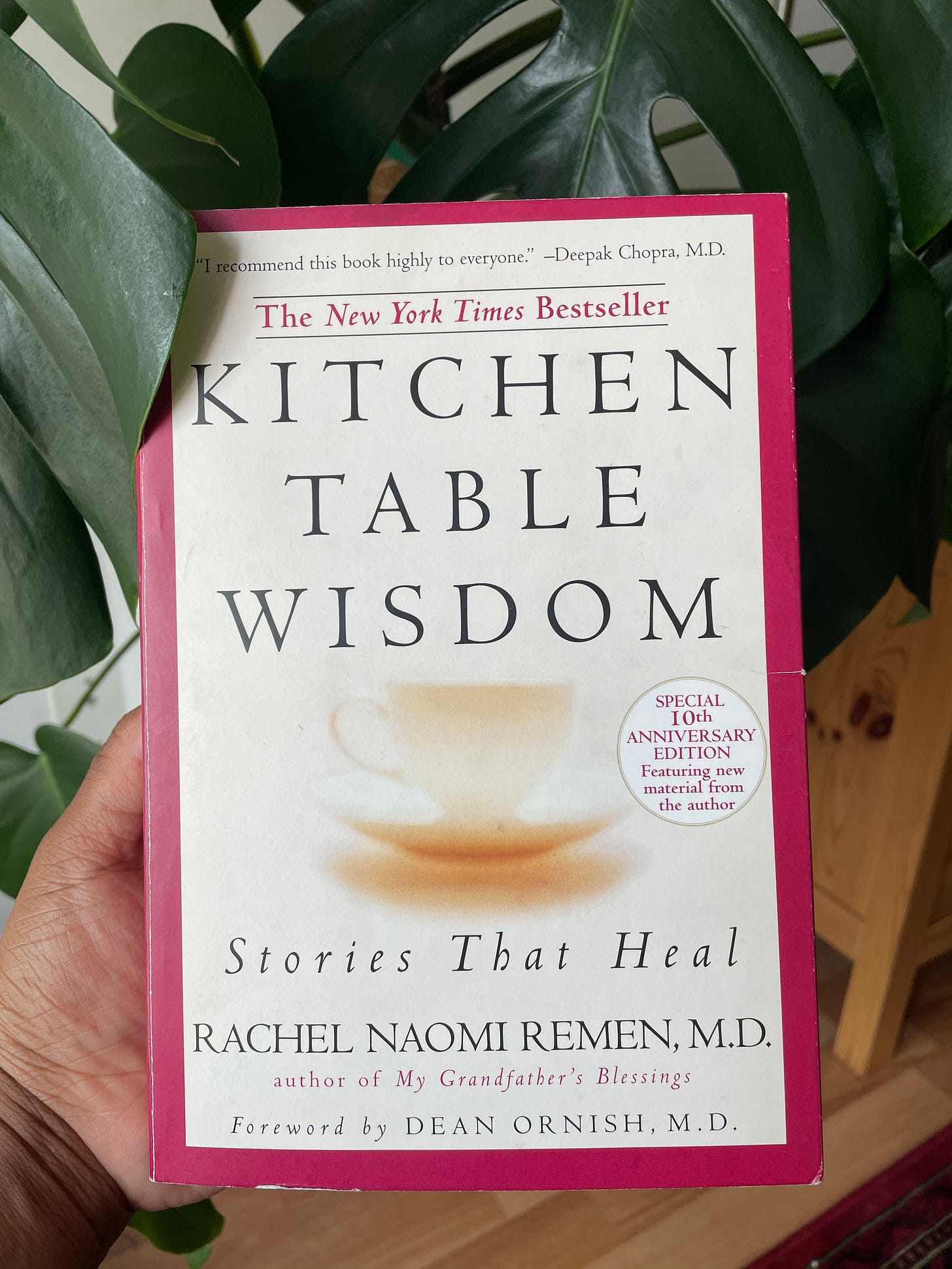Silly me, I almost forgot that feeling my grief is the point of it all.
on facing the tears and the messiness of healing.
One of my favourite books is Kitchen Table Wisdom, a quiet classic about the inescapable grief woven through the helping professions. I found it by chance on a back shelf at my local bookstore. I cracked it open, started reading, and stayed put long enough that my husband finally spotted me on the floor, 40 minutes gone in a heartbeat. It’s the kind of book that steals time in the best (and worst) way.
I never expected that it would become the book I’d lean on for the next six years. Yet here we are: pages dog-eared, cover scuffed from subway rides and vacations, and me recommending it to literally anyone who’ll listen.
Last year most of the Bloom team and I finished an 18-hour course and became Certified Grief-Informed Professionals. The training covered all sorts of loss: ambiguous grief from estrangement with a narcissistic parent, reproductive and fertility grief, the layered heartache that follows spiritual trauma, plus many others.
Ironically, long before I signed up for that course, life had already enrolled me in its own grief curriculum:
The grief of friendships I thought would last.
The grief and loneliness of being a sole founder and wishing there was someone I could lean on when decision making got hard.
The grief of planning a wedding for two years only to cancel it days before (thanks Covid!)
The grief of medical trauma during my son’s birth, writing my will on the way to an emergency C-section.
The grief of losing my last living grandparent 5 weeks postpartum and grieving for my son who’d never get to meet his great grandma.
I could name dozens more losses from the past five years alone. I bet many of you reading this can too.
Dr. Rachel Naomi Remen in Kitchen Table Wisdom writes, “The expectation that we can be immersed in suffering and loss daily and not be touched by it is as unrealistic as expecting to walk through water without getting wet.”
No matter what we plan, grief finds us and soaks us through. The task isn’t to stay dry; it’s to wring ourselves out, gently and often, and trust that with enough sunlight we will dry again.
🗓 Grief refuses a schedule (and that’s not a moral failing).
If you’re anything like me, you’ve tried to pencil sorrow into the edges of your day. A good cry after the last therapy Zoom call, a wistful minute before daycare pick-up, or my personal favourite — a full breakdown the moment the shower water hits my face. Convenience and grief do not share a calendar, so we improvise.
After a decade of sitting with loss personally and professionally, I have learned that grief laughs at our planners. It slips in when we are burned out, under-resourced, or halfway through reheating leftovers. Chimamanda Ngozi Adichie calls grief “a cruel kind of education.” If she’s right, then the syllabus always arrives mid-semester with no warning. When the wave hits at a terrible moment, short-term coping is not failure; it is first aid.
So we breathe. Call our therapist. Text a friend memes. Watch a ridiculous baking show. It doesn’t count as avoidance (in my eyes) if you promise earnestly to circle back. Grief therapist and author Megan Devine reminds us that some pains “cannot be fixed; they can only be carried.” Quick comforts buy your shoulders enough time strength to lift the load again.
🌀 The in-between space + field tested strategies
Ultimately, grief’s pop quizzes are guaranteed, but our responses don’t have to be a guessing game. Today’s letter contains a few of my most used and field-tested strategies for the minutes, hours, or days when sadness and grief barge in without notice.
1. Name the ache
Acceptance and Commitment Therapy (ACT) teaches a skill called “cognitive defusion” — the art of noticing thoughts and feelings without being swallowed by them. One way to practice this skill is by naming the difficult experience in question.
Try giving your grief a title: Grief with a capital G, Aunt Sad, The Great Ache, That Loud Neighbour Upstairs, or my personal fave: The Reliable Menty B.
Personifying the pain grief can bring often creates just enough distance to see it clearly without identifying with it. “Oh, there goes Aunt Sad again, telling me I should have done something sooner.” In the space between you and your grief externalized, there’s a little more space for compassion to exist.
2. Catch your breath.
From a somatic lens, emotion is a full-body event. Grief can yank us straight into fight-or-flight, leaving a racing heart and shallow breath. Gentle regulation helps the mind follow the body back to safety.
Paced breathing is one of my favourites: inhale for 2 or 3 counts, exhale for 4 to 6 counts. The longer out-breath nudges the parasympathetic system (the body’s built-in brake pedal) and says, “We are safe enough right now.” Ten slow cycles can feel like opening a window in a stuffy room. A true respite when it’s hard to simply catch your breath.
3. Bring grief to the art table
Expressive arts therapy invites us to speak with colour, texture, and rhythm when words run out. Those who have been following my work for the last little while , have seen my evolution into bringing more of my creativity into my work, journeyed with me in expressing feelings through art both online and off, and have explored the ways we can use art prompts to cultivate growth and healing. All this to say is that in my experience, grief lives beneath language. Which is why using art can be a side step and a soft journey into healing that bypasses “just talking it through.”
Practical art invitations:
✍🏾 Journal prompt: “If my grief had a shape, what would it look like on paper? Draw it first, then write a letter to it.”
🎨 Collage prompt: Cut out images that carry both loss and hope, then arrange them side by side. Notice what stories emerge in the gaps.
🧘🏾 Movement prompt: Put on the song that breaks you open and let your body move until the music is finished — no choreography, just truth.
🖼 Photography prompt: Capture three images of absence (an empty chair, a half-eaten plate, the indentation on a pillow) and explore in whatever way feels right on what each one says to you about love and loss.
4. Drop the forced gratitude
It’s not a secret that we live in a culture that wants every wound wrapped in a lesson, and tied with a bow. But silver linings are not mandatory homework. Forcing gratitude is a form of bypassing authentic feeling. Let yourself feel what you feel first without pressuring a positive spin when discomfort shows up.
Instead, try these reminders:
I am allowed to grieve without hunting for a silver lining.
My grief has no deadline or hard stop.
Experiencing sorrow makes me deeply human. I deserve humanity.
Presence, not positivity, is the doorway toward healing.
Let the bruise bloom first; gratitude can wander in later,
on its own schedule, and on its own time.
5. Shrink the time frame.
Neurologically, grief hijacks executive function, making ordinary tasks feel like trying to file your taxes on Mars, or climb a hill with no peak. When overwhelm hits, zoom in to a bite-size window.
Orient: Notice five objects around you.
Choose: Ask, “What matters most in the next 30 seconds?” Maybe it is a sip of water.
Act: Do only that.
Repeat: Expand to the next minute or five.
Small mercies compound, nudging your nervous system back toward its window of tolerance.
5. Share the burden, lean on others.
Grief is personal but rarely private. Sharing in a support group, with a trusted therapist or over 2 a.m. voice notes with your bff, cracks the myth that grief is a burden that we have to carry alone. I often come back to the wisdom of allowing space for us to feel pain without needing to suffer (a DBT radical acceptance lesson). Suffering feels like grieving in isolation. Honouring our pain often means letting someone else hold it with you.
Reflection prompts for more insight and feeling:
Avoidance audit: What are three ways I dodge my grief? What would “turning toward” look like today?
Body scan: Where does sadness live in my body right now, and how does it want me to move?
Letter to loss: Write to the part of you that is hurting and ask what it needs for the next twenty-four hours.
Compassion check-in: Finish the sentence, “If my best friend felt this, I would tell them…” Then offer those words to yourself.
A closing invitation
When sadness shows up unannounced, try slipping off the emotional noise-canceling headphones instead of ignoring it all together. Let grief in. Allow it space to tell the story of how you have loved, and lost. Sitting with feelings — especially the ones associated with grief, isn’t just an inconvenient detour away from “normality;” it’s the only road forward.
Grieving is self care. We grieve because we care. It not only makes us human, but it’s kind of the whole point. A common phrase states there are only two guarantees in life: death and taxes. I’d argue grief is the unspoken item on that list, right at the top. We feel it because we are feeling beings. Our feelings offer us signals that don’t always have to mean something either. However, when they do, deep insights and real healing can follow.
On the days you can’t bear the conversation alone, remember that for as long as you are human, you are never alone in your grief. Not fully at least. Maybe it’s comforting to remember that we’re all in this together in some way. Loss unifies us privately and publicly in ways we don’t always have the language to name.
Of course, there is always space for you right here, in this moment, with these words. Linger as long as you’d like. Save it for a rainy day. All feelings welcomed.
Until next time,
—Meghan 🤎













I saved this post to read later and am finally making some space for it. The topic of grief comes up SO often for me, in my own life and among friends. Which makes sense, living in this messed up world and within a culture that is incredibly emotionally dysfunctional. When I began working with my current therapist, one of the first things I shared was that I needed assistance in grieving, somehow knowing that it is not the grief that I need to be afraid of. And yet, I still find myself running from it! So, sitting with your gentle and wise words while I continue to learn to be less afraid. Thank you, Meghan.
The words coming to me right now, are thank you. I feel this, and I appreciate the insights and gentle reminders. Sending you big warm hugs, and my love. 🖤